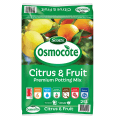

How to grow & care for plum trees
Plum trees are productive fruit trees, ideally suited to growing in the average backyard or in a large pot. There are many varieties of plums (including Australian native plums) to choose depending on your flavour preference and what you want to do with the fruit - eat the plums fresh or use them to make jams or chutneys.
Plum trees are long lived and tall growing, but they can be pruned to a manageable height of 5-6 metres or you can find dwarf varieties that will grow to 2 metres. Japanese plums (Prunus salicina) or European plums (Prunus domestica) prefer growing in regions with warm summers and cool winters. However there are plenty of species and cultivars of plums that have “low chill” requirements or are actually indigenous to subtropical and tropical regions. Ask at your local nursery for a plum tree best suited to your climate.
Many plums will need a second tree for pollination, but if you don’t have the space for 2 trees look for a self-fertile (or self-pollinating) variety - there are many to choose from!
Top 5 steps to growing plums
- Choose a full sun position in your garden or grow a dwarf variety in a large pot.
- Look for a self-fertile variety unless you have the space for 2 or more trees.
- Netting plum trees is essential to protect your crop from birds.
- Plums will taste best when they are allowed to ripen on your tree. Pick them when they’ve reached their maturity colouring and are slightly soft to the touch. Enjoy!
- Ask at your local nursery for a plum that grows best in your climatic zone
Shopping List
- Bare-rooted or potted plum tree
- Scotts Osmocote Compost Premium Soil Improver
- Scotts Osmocote Plus Organics Citrus & Fruit Plant Food & Soil Improver
- If growing in pots, Scotts Osmocote Citrus & Fruit Potting Mix
- Garden spade
- Mulch
- Secateurs
- Wildlife safe crop protection netting
Prepare
Plum trees prefer a full sun spot in a well drained soil and they do require regular watering when fruiting. Prepare the soil for planting by digging a hole that’s twice as wide as the root ball of your tree and the same depth.
Loosen the soil at the bottom of the hole and mix Scotts Osmocote Compost Premium Soil Improver and Scotts Osmocote Plus Organics Citrus & Fruit Plant Food & Soil Improver through the original soil.
Planting in the garden
Growing from bare-rooted or potted trees
Bare-rooted plum trees can be purchased and planted in winter when the tree will be dormant. Potted plums can be planted at any time, except in the heat of summer.
Plant your plum tree at the same depth it was in the pot or if bare-rooted make sure any graft on the truck is well above the soil surface. Add a stake to support bare-rooted trees at planting - this can be removed once the roots have taken.
Firm down the soil around the roots of your newly planted plum tree and water in well. Top dress around the tree with an open organic mulch (but avoid touching the trunk) to suppress weeds and retain moisture.
Planting in pots
You can grow plum trees in large pots or containers so long as they have good drainage. Be sure to choose a self-fertile plum if you only want 1 tree - something like a dwarf Santa Rosa is perfect in pots.
A half wine barrel with drainage holes added is an ideal pot size for a dwarf plum tree. Fill your pot with a premium potting mix like Scotts Osmocote Citrus & Fruit Potting Mix before planting your bare-rooted or potted plum tree into it.
Firm down the soil around your newly planted tree in the pot and water it in well to settle its roots in nicely.
Mulch the top of the soil in the pot to retain moisture and ensure the pot can be easily watered during the summer months.
Harvest
Typically plums are harvested anywhere from early summer to late autumn - however, when your plums will be ready for harvest will depend on the species or cultivar you’re growing and your climatic conditions.
Plums are best picked when they’ve changed completely to their ripe mature colouring - this will vary between species or cultivars. A plum ready to harvest will come away easily from the tree and is best eaten within a few days of harvest.
You’ll need to securely net your plum trees to protect the crop from hungry birds and other animals. Once the plums are formed use a wildlife safe, 4mm hole or smaller white netting that’s pulled tightly over the tree and secured around the truck or set up a frame structure over the tree so you can easily place the net over this.
Pests & Diseases & General Care Advice
Established plum trees should be pruned in winter when dormant to an open vase shape and fertilised in summer and again in autumn with Scotts Osmocote Plus Organics Citrus & Fruit Plant Food & Soil Improver.
Pear and Cherry Slug can infest plum tree leaves - causing the leaves to look skeletonised. Dust wood ash into the trees to control these slimy pests.
Watch for Queensland Fruit Fly infestations with monitor traps and by regularly cutting into your plum fruit to check for maggots. If you find fruit fly, use bait and wildlife safe insect exclusion netting to protect your plum crop from further attack. Always pick up any fruit that falls to the ground and dispose of it.



